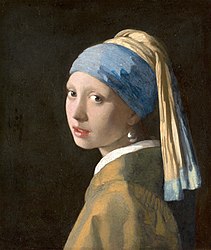Archivo:Johannes Vermeer - Girl with a Pearl Earring - WGA24666.jpg

Ver la imagen en su resolución original (1000 × 1197 píxeles; tamaño de archivo: 111 kB; tipo MIME: image/jpeg)
|
|
Este es un archivo de Wikimedia Commons, un depósito de contenido libre hospedado por la Fundación Wikimedia. Más abajo se reproduce su página de descripción con la información sobre su origen y licencia. |
| Johannes Vermeer: La joven de la perla
|
||||||||||||||||||||||||||||
|---|---|---|---|---|---|---|---|---|---|---|---|---|---|---|---|---|---|---|---|---|---|---|---|---|---|---|---|---|
| Artista |
artist QS:P170,Q41264 |
|||||||||||||||||||||||||||
| Título |
Girl with a Pearl Earring |
|||||||||||||||||||||||||||
| Object type |
pintura |
|||||||||||||||||||||||||||
| Género |
Tronie |
|||||||||||||||||||||||||||
| Fecha |
hacia 1665 date QS:P571,+1665-00-00T00:00:00Z/9,P1480,Q5727902 |
|||||||||||||||||||||||||||
| Técnica |
óleo sobre tela medium QS:P186,Q296955;P186,Q12321255,P518,Q861259 |
|||||||||||||||||||||||||||
| Dimensiones |
altura: 46,5 cm; ancho: 40 cm dimensions QS:P2048,46.5U174728 dimensions QS:P2049,40U174728 |
|||||||||||||||||||||||||||
| Colección |
institution QS:P195,Q221092 |
|||||||||||||||||||||||||||
| Número de inventario |
670 (Mauritshuis) |
|||||||||||||||||||||||||||
| Ubicación del objeto |
|
|||||||||||||||||||||||||||
| Historial de la pieza |
|
|||||||||||||||||||||||||||
| Exhibition history |
|
|||||||||||||||||||||||||||
| Inscripciones |
|
|||||||||||||||||||||||||||
| Referencias |
|
|||||||||||||||||||||||||||
| Control de autoridades | ||||||||||||||||||||||||||||
| Fuente/fotógrafo |
Web Gallery of Art: reference_wga QS:P973,"http://www.wga.hu/html/v/vermeer/03b/22pearl.html" |
|||||||||||||||||||||||||||
| Permiso (Reutilización de este archivo) |
|
|||||||||||||||||||||||||||
| Otras versiones |
|
|||||||||||||||||||||||||||
Leyendas
Elementos representados en este archivo
representa a
Historial del archivo
Haz clic sobre una fecha y hora para ver el archivo tal como apareció en ese momento.
| Fecha y hora | Miniatura | Dimensiones | Usuario | Comentario | |
|---|---|---|---|---|---|
| actual | 18:12 6 abr 2015 |  | 1000 × 1197 (111 kB) | Frmorrison | Reverted to version as June 2011, because there is no reason to have a 8MB file |
| 12:52 21 jun 2014 |  | 4094 × 4789 (8,6 MB) | Jan Arkesteijn | higher resolution | |
| 10:57 4 jun 2011 |  | 1000 × 1197 (111 kB) | JarektUploadBot | {{Artwork |artist = {{Creator:Johannes Vermeer}} |title = Girl with a Pearl Earring |description = |date = {{other date|ca|1665}} |medium = {{Oil on canvas}} |dimen |
Usos del archivo
La siguiente página usa este archivo:
Uso global del archivo
Las wikis siguientes utilizan este archivo:
- Uso en en.wiki.x.io
- Uso en fa.wiki.x.io
- Uso en he.wiki.x.io
- Uso en hr.wiki.x.io
- Uso en sl.wiki.x.io
- Uso en sq.wiki.x.io
Metadatos
Este archivo contiene información adicional, probablemente añadida por la cámara digital o el escáner usado para crearlo o digitalizarlo.
Si el archivo ha sido modificado desde su estado original, pueden haberse perdido algunos detalles.
| Comentario de archivo JPEG | VERMEER, Johannes
(b. 1632, Delft, d. 1675, Delft) Girl with a Pearl Earring c. 1665 Oil on canvas, 46,5 x 40 cm Mauritshuis, The Hague <I>Signature:</I> Signed top left. <I>Provenance:</I> The provenance of this painting cannot be traced back very far. All earlier documents or sales catalogs cited by Blankert are pure guesswork. Vermeer seems to have painted a number of "heads," and various cited 'tronie', as they were called, cannot be further identified. We only know for certain that the work was purchased at the beginning of 1882 for the collection A. A. des Tombe of The Hague for fl. 2.30 in the sale Braam of the same city. The des Tombe collection was a public collection and bequeathed the picture in 1903 to the Mauritshuis. This charming portrait of a girl is unfortunately in a very poor state of conservation and suffered from numerous extensive restorations. It is furthermore marred by an ugly pattern of cracks. Nevertheless, it became famous after its rediscovery and was dubbed the "Gioconda of the North" by many enthusiastic critics. Fortunately, enough of the original is left to permit the savouring of a truly outstanding and partly exotic work. The girl is seen against a neutral, dark background, very nearly black, which establishes a powerful three-dimensionality of effect. Seen from the side, the girl is turning to gaze at us, and her lips are slightly parted, as if she were about to speak to us. It is an illusionist approach often adopted in Dutch art. She is inclining her head slightly to one side as if lost in thought, yet her gaze is keen. The girl is dressed in an unadorned, brownish-yellow jacket, and the shining white collar contrasts clearly against it. The blue turban represents a further contrast, while a lemon-yellow, veil-like cloth falls from its peak to her shoulders. Vermeer used plain, pure colours in this painting, limiting the range of tones. As a result, the number of sections of colour are small, and these are given depth and shadow by the use of varnish of the same colour. The girl's headdress has an exotic effect. Turbans were a popular fashionable accessory in Europe as early as the 15th century, as is shown by Jan van Eyck's probable self portrait, now in the National Gallery in London. During the wars against the Turks, the remote way of life and foreign dress of the "enemy of Christendom" proved to be very fascinating. A particularly noticeable feature of Vermeer's painting is the large, tear-shaped pearl hanging from the girl's ear; part of it has a golden sheen, and it stands out from the part of the neck which is in shadow. In his Introduction to the Devout Life (1608), which was published in a Dutch translation in 1616, the mystic St Francis De Sales (1567-1622) wrote, "Both now and in the past it has been customary for women to hang pearls from their ears; as Pliny observed, they gain pleasure from the sensation of the swinging pearls touching them. But I know that God's friend, Isaac, sent earrings to chaste Rebecca as a first token of his love. This leads me to think that this jewel has a spiritual meaning, namely that the first part of the body that a man wants, and which a woman must loyally protect, is the ear; no word or sound should enter it other than the sweet sound of chaste words, which are the oriental pearls of the gospel." From this it is clear that the pearl in Vermeer's painting is a symbol of chastity. The oriental aspect, which is mentioned in the above extract, is further emphasised by the turban. The reference to Isaac and Rebecca suggests that this picture could have been painted on the occasion of this young woman's marriage. So to that extent it is a portrait. There is surely a similar explanation for the Head of a Girl dressed in a smart, grey dress (Metropolitan Museum of Art, New York). One must admire the artist's technique, which features application of the pigments in juxtaposition and melting, avoiding precise lines, and therefore blurring the contours of different colours so as to obtain effects that foreshadow those of the impressionists. The dark backgrounds that Vermeer chose in these two portraits enhance the plasticity of the models.
Author: VERMEER, Johannes Title: Girl with a Pearl Earring Time-line: 1651-1700 School: Dutch Form: painting Type: portrait |
|---|




